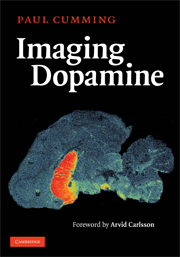Book contents
- Frontmatter
- Contents
- Foreword
- Acknowledgments
- Introduction
- 1 The life history of dopamine
- 2 Enzymology of tyrosine hydroxylase
- 3 The assay of tyrosine hydroxylase
- 4 Enzymology of aromatic amino acid decarboxylase
- 5 PET studies of DOPA utilization
- 6 Conjugation and sulfonation of dopamine and its metabolites
- 7 Dopamine synthesis and metabolism rates
- 8 MAO activity in the brain
- 9 Vesicular storage of dopamine
- 10 Dopamine release: from vesicles to behavior
- 11 The plasma membrane dopamine transporter
- 12 Dopamine receptors
- 13 Imaging dopamine D1 receptors
- 14 Imaging dopamine D2 receptors
- 15 Factors influencing D2 binding in living brain
- 16 The absolute abundance of dopamine receptors in the brain
- 17 Conclusions and perspectives
- References
- Index
- Plate section
11 - The plasma membrane dopamine transporter
Published online by Cambridge University Press: 04 December 2009
- Frontmatter
- Contents
- Foreword
- Acknowledgments
- Introduction
- 1 The life history of dopamine
- 2 Enzymology of tyrosine hydroxylase
- 3 The assay of tyrosine hydroxylase
- 4 Enzymology of aromatic amino acid decarboxylase
- 5 PET studies of DOPA utilization
- 6 Conjugation and sulfonation of dopamine and its metabolites
- 7 Dopamine synthesis and metabolism rates
- 8 MAO activity in the brain
- 9 Vesicular storage of dopamine
- 10 Dopamine release: from vesicles to behavior
- 11 The plasma membrane dopamine transporter
- 12 Dopamine receptors
- 13 Imaging dopamine D1 receptors
- 14 Imaging dopamine D2 receptors
- 15 Factors influencing D2 binding in living brain
- 16 The absolute abundance of dopamine receptors in the brain
- 17 Conclusions and perspectives
- References
- Index
- Plate section
Summary
Molecular biology of DAT and regulation of expression
The DAT gene cloned from a rat brain expression library codes for 620 amino acids, with a sequence predicting 12 transmembrane domains (Giros et al. 1991). Its expression in various cell lines confers vulnerability to the toxin MPP+ (Pifl, Giros, & Caron 1993), in addition to conferring the ability to transport dopamine. The uptake of dopamine in striatal slices and synaptosomes has a saturable component with high affinity, and apparently also a high-capacity, low-affinity site (Mireylees, Brammer, & Buckley 1986). It is the saturable component that is characterized by sensitivity to cocaine and related compounds. Thus, the potency of many drugs displacing [3H]cocaine from striatal membranes is highly correlated with the inhibition of [3H]dopamine uptake in slices or synaptosome preparations (Madras et al. 1989).
The intracellular domain of DAT presents several potential sites for phosphorylation by protein kinases C and A (Giros et al. 1992). Treatment with phorbol esters, which activate PKC directly, reduced the maximal velocity of [3H]dopamine uptake by synaptosomes from rat striatum (Copeland et al. 1996), and also reduced the velocity of dopamine uptake in frog oocytes expressing human DAT (Zhu et al. 1997). This latter reduction in velocity was associated with reduced [3H]mazindol binding to intact cells, without any concomitant change in the ligand binding to homogenates, which indicates that the treatment altered the association of functional transporters with the plasma membrane.
- Type
- Chapter
- Information
- Imaging Dopamine , pp. 137 - 159Publisher: Cambridge University PressPrint publication year: 2009



